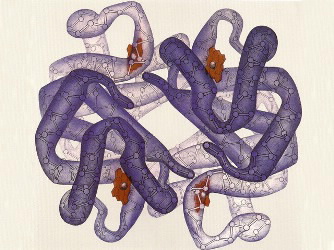An international team of scientists, including ANSTO’s Dr Chris Garvey, have discovered that haemoglobin molecules have evolved to carry oxygen best at different body temperatures in different animals.
 |
| Haemoglobin Protein Representation |
Haemoglobin is a protein found in red blood cells that binds to and carries oxygen. Haemoglobin binds to oxygen when blood moves through the lungs, and releases oxygen as it moves through capillaries in body tissues.
The protein is made up of four polypeptide chains, and each subunit surrounds a haem group, where the oxygen can bind.
Scientists already knew that oxygen binding and release happens most efficiently when the haemoglobin molecule partly unfolds and softens.
Environmental factors, such as temperature, can affect the shape and folding of a protein. Therefore, the team of researchers set out to find out how haemoglobin works in a range of animals with different body temperatures.
The research team used neutron scattering techniques to measure the flexibility and softness of haemoglobin at different temperatures. The scientists tested haemoglobin from three endothermic animals (a human, a platypus, and a chicken) and one ectothermic animal (a salt-water crocodile).
The scientists found that the haemoglobin protein softened and partly unfolded at the exact body temperature of each endotherm. However, the folding of the crocodile haemoglobin did not change much with temperature.
The results suggest that haemoglobin structure has evolved in different endotherms to work most efficiently at the animal’s body temperature. However, more research is needed to form strong conclusions about haemoglobin evolution.
References
Stadler et al. 2012. Thermal fluctuations of haemoglobin from different species: Adaptation to temperature via conformational dynamics. Journal of the Royal Society. doi: 10.1098/rsif.2012.0364.
Published: 18/01/2012


